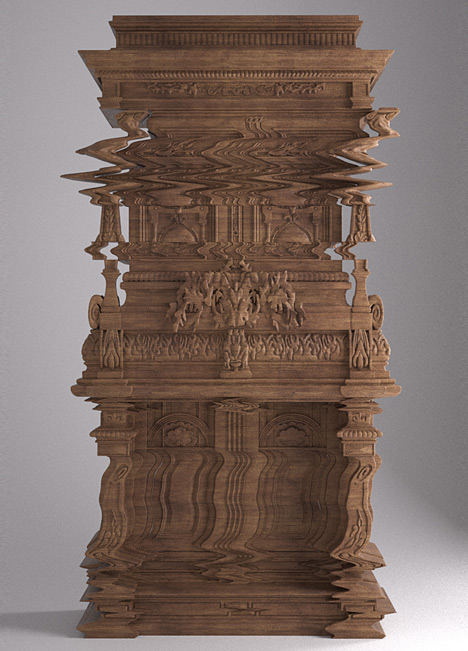What does nostalgia for broken things say about us? Over the last year or so, we’ve undoubtedly seen an exponential increase of the intentional “glitch” used in visual arts. The glitch – defined as a short-term fault in a system – has gained tremendous popularity as a visual style. My theory is that a person’s predilection toward a preference for random events can be explained as both a desire for nostalgia and perhaps even a loss of control – and that very act of self-awareness can aid in becoming a better thinker and artist.
While fumbling through YouTube recently, I was struck by a video on the Idea Channel that discussed how ‘glitchy art show[s] us broken is beautiful.’ In today’s modern world, where analog systems have been mostly replaced by digital systems, technology either works or it doesn’t. However, on older systems, whether it be videotape or 8-track or shooting film, there exists the ability of said systems to mostly work – or kind of work. This very thing injects a degree of random variables into the output (whatever that output may be).
If you were born before 1990, chances are that you’re quite aware of this very thing. As creative people reach the age of exploration, they excavate their personal history and observations for ideas of inspiration, which has made this ‘glitchy’ set of characteristics a veritable inevitability. I have found that oftentimes, creative people are drawn to undiscovered and, as such, undervalued assets (even if only in their mind). The more prevalent something is, the less appealing. And so, as a component of nostalgia, we search to elevate details of our past and celebrate either the mundane (yet chronologically specific) or the sentimental. The very thrill of that discovery may even supersede the intellectual or conceptual backbone that supports it. This leads to kitsch, gimmick or ultimately vapid work. It is the difference between Cindy Sherman and James Franco impersonating Cindy Sherman.
Here’s where we make a little bit of a jump. We’ve witnessed the ‘glitch’ trend. We’ve established that its characteristics are rooted in nostalgia. Now we must look at an additional perspective of the glitch itself - why do ‘artists’ leave creative decisions to chance? On the one hand, one could argue that the unknown element can help to create something completely unforeseen therefore helping to elevate the art form. On the other hand, what is a more worthwhile contribution to the art form: trial and error through a series of random events…or well-thought out and well-executed projects, using experimentation to establish the best possible final result?
There is no doubt that random occurrences have the potential to elevate our work. But as artists, we must remember that these chance instances should exist as a means to open our eyes to more opportunities and exploration of the project or the medium. They should not exist as the end in and of itself. Lazy work stops at the moment of discovery. Worthwhile work uses the moment of discovery as a launch point to develop even better work. Andy Warhol drew a line in the sand and stood on it – and it was that very thing that helped to establish his position in the art community. Warhol’s own soup cans even harbored a bit of nostalgia – he painted something he ate for 20 years and saw everyday – but again, he still used it as his jumping off point and not as the final product.
It is also worth recognizing that there is a difference to what degree (and at what part in the process) that a ‘glitch’ affects the outcome of the final product. Ferruccio Laviani created an absolutely mind-blowing piece of furniture that has the appearance of a distorted digital image.
At the other end of the spectrum we have this: an image of an dresser manipulated using a ‘glitch image’ algorithm.

Although both these two things are of entirely different mediums (furniture versus a manipulated photograph), the point remains the same. Laviani used the distortion as a means to shape and add dimension to something (in this case, his furniture design). The distorted photo ends shortly after it begins. We are comparing steel (an alloy of iron and carbon) with iron painted to look like steel. Work that is fundamentally altered at the micro level will always be stronger. Focusing on the outward appearance of our work rather than what makes up its core content is a recipe for mediocrity at best and failure at worst.
To get to the core of our work, we must get to some hard truths about ourselves and determine what type of person we are. For simplicity’s sake, let’s say that most creatives fall into one of three categories:
1. Passive
2. Passive-aggressive
3. Aggressive (In control)
Passive people lack general control of their environment. If they are shooting a person, they offer little direction. They often react instead of anticipate. Many people start here, and that’s fine. Technical discovery is large part of this process.

Some might find it odd to use a personality disorder as a classification here, but passive-aggressive disorder is defined as “an indirect expression of hostility, through procrastination, sarcasm, hostile jokes, stubbornness, resentment, sullenness, and deliberate repeated failure to accomplish requested tasks.” Most creatives will find themselves in this category (even if they are unable to admit it). We must be able to acknowledge this stage before we are able to sustain growth and move beyond it. There is often a subconscious fear of leaving this stage - by allowing outside elements to play an integral part in the work, one is able to place at least partial blame of any failure on someone or something else and could explain why some do not wish to take full control of the work. Technical discovery is minimal, but personal discovery can be a large part of this process. Being able to channel these feelings can oftentimes produce some of the most important work of one’s career. With meaningful work, one can move up to the next category.
Although aggressive is not the most complimentary word to use here, it does sound better in the list. What we are talking about is being in control. When I was assisting, one of the core elements of my teaching was being able to “control my environment.” This is not to say that we are required to control every element within the frame, just that we are capable of doing so. A grasp on this will actually allow more freedom to be creative. A musician does not start out with jazz improvisation – one must first learn the scales. Almost every very successful photographer is in this category (even if their personality is not “aggressive,” they understand how to expertly manage the photograph). Discovery is replaced with exploration – ideas, concepts and taking the medium to new places.
What does a dependence on the random say about one’s work? Truthfully, I really don’t know. In the age of a perfect, digital image, elements of imperfection can give gravity and realism to one’s work. But as we’ve seen, these elements can be seen as a crutch or a gimmick. There is a fine line between good art and kitsch. Oftentimes it’s easy to look at an image and ask, 'Have I gone too far?' but maybe the more appropriate question is ‘Have I gone far enough?’
Why do some artists want random elements to control part of their work? What does that relinquishment of control say about them and, more importantly, what they're creating? 'Glitches' should be the inspiration for more discovery, not simply added to make the art have more "visual interest." If some artists are looking too much into the past for their inspiration, what happens when the trend of nostalgia is over? What's next?
Original video via Idea Channel











Post-modern artists try so hard to be original by stripping everything artistic away from their work, and all they end up doing is insulting the creative intelligence/sensibilities of the viewer.
Unless it's architecture. Post-modern architecture is badass.
That's why I roll my eyes every time I see someone gushing about "finding beauty in the imperfect." Wow, aren't you just a revolutionary.
That's strange to find someone in the gray camp nowadays, as modern architecture is way more popular than postmodern. Architectural magazines dominantly feature and advertise modern designs (albeit the materials used on the new buildings would probably be too flamboyant for Neutra). I especially enjoy when architects play with perspective like the Pocinho Rowing Center (photo credit: Joao Morgado). But an embellishment here or there never killed anyone ;)
I guess I just always think of modern architecture as the era of skyscrapers and function over form. I guess it's a less contemporary view of modern architecture.
When it comes to postmodern architecture though; I mean look at this thing man. I have no idea if it's even possible to live or work inside this it but...Just look at it.
#frankgehrydabomb
They no longer symbolise, they only use signs.
Whoa. Bit heavy for a Monday morning FStoppers read. But a damn fine read nonetheless.
Thanks Christian!
I think there's a lot of oversimplification in this article, and I think the author dances around his central point without ever stating it. What I got from this article is, "A gimmick can't save bad work."
But using a gimmick, or what you might consider a gimmick, doesn't necessarily make the work bad. Looking at the glitch example, the furniture piece is undoubtedly gimmicky, but it's still an astounding piece of art, mostly because of the gimmick. It takes an accidental artifact of digital media - a glitch - and very purposefully, painstakingly even, applies it to a physical object. It addresses questions of reality in a digital age as well as the shift in the way we experience art. All through intelligent application of a gimmick.
On the other hand, the photo of the dresser was not a good photo to begin with. It's visually and technically boring. Adding the glitch effect doesn't change that.
Thanks for the response Matt! Hopefully I can try to help clarify the point I was making. It's not that a gimmick can't save bad work, but that if the gimmick is the end of the thought process, the work doesn't amount to anything substantial. Part of the article posed the question about what relying on random characteristics says about the artist. I have no answer for it, I'm just trying to pose the question.
I acknowledged how amazing the piece of furniture was - a large part of why it's amazing is because it does not rely on the glitch. It was part of the process of discovery that lead to the final result. The image (yes, a very bad image) was used as a metaphor to illustrate how depending on a gimmick produces garbage (whether it looks like garbage or manages not to and is just a 'polished turd'). The point you had about having purposeful intention was exactly the point I was making by comparing a metal alloy (steel) to painted iron. One is strong (at the chemical level) and well-created. The other is weak and changed only by paint on the surface.
Ultimately, you're absolutely right. Garbage in, garbage out. No one is arguing that. I was ultimately trying to probe much deeper than that oversimplification - why do some artists want random elements to control part of their work? What does that mean for them and what they are creating? Shouldn't 'glitches' help aid us in discovery, not be the destination of discovery itself? Are some artists looking too much into the past for their inspiration instead of looking toward the unknown for innovation? What happens when the trend of nostalgia is over? What's next? (I may add this into the original article) Thanks Matt!
I loved reading the article and comments. So well put and written (specially for a spanish reader). I understand and agree on most of it, but isn't complaining about the way others do things creatively a little passive agresive itself? I mean, there has always been admired and popular rubish, and completely unknow genius. I like to think that in creativity anything works, we should create freely; it doesn't matter the technique if the creator doesn't want to care about it. Most pieces without technique or control will be most likely uninsteresting, but maybe somebody does something interesting, even if it is by chance. Also, what can we do or should if some absolute shit succeeds? I guess just be courious about why it succeded or just ignore it completely and keep on our own track.